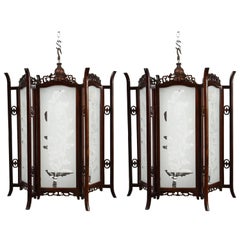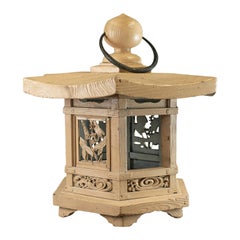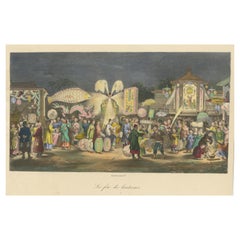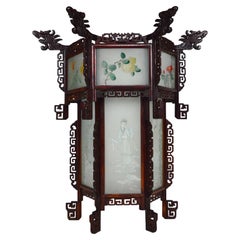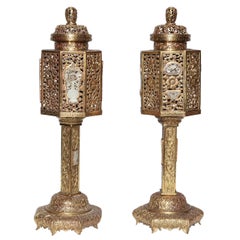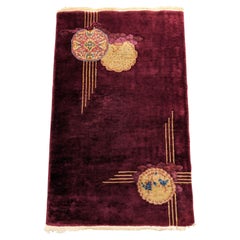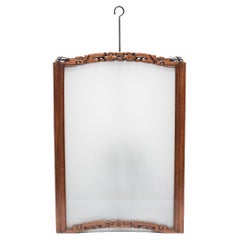Antique Chinese Lantern
19th Century Chinese Qing Antique Chinese Lantern
Glass, Rosewood
Late 19th Century Chinese Chinese Export Antique Chinese Lantern
Cedar
Mid-19th Century Antique Chinese Lantern
Paper
Early 1900s Chinese Chinese Export Antique Chinese Lantern
Glass, Wood, Paint
19th Century Chinese Antique Chinese Lantern
Jade, Brass
1920s Chinese Art Deco Antique Chinese Lantern
Wool
1920s Futurist Antique Chinese Lantern
Pastel
Mid-19th Century Chinese Qing Antique Chinese Lantern
Metal
Early 20th Century Chinese Qing Antique Chinese Lantern
Hardwood, Glass
Early 20th Century Chinese Qing Antique Chinese Lantern
Hardwood, Glass
Early 20th Century Chinese Antique Chinese Lantern
Iron
Early 20th Century European Arts and Crafts Antique Chinese Lantern
Brass
Early 20th Century Chinese Antique Chinese Lantern
Jade, Tourmaline, Silver
Early 20th Century Chinese Other Antique Chinese Lantern
Wool
19th Century Chinese Chinese Export Antique Chinese Lantern
Bronze
1920s American Art Deco Antique Chinese Lantern
Gouache
Late 19th Century Chinese Antique Chinese Lantern
Bronze
19th Century Antique Chinese Lantern
Iron
19th Century Antique Chinese Lantern
Iron
19th Century Antique Chinese Lantern
Iron
Mid-19th Century Chinese Antique Chinese Lantern
Porcelain
Early 20th Century Chinese Qing Antique Chinese Lantern
Porcelain
1890s Chinese Antique Chinese Lantern
Ironstone
Early 20th Century Chinese Qing Antique Chinese Lantern
Hardwood, Glass
Early 20th Century Chinese Chinoiserie Antique Chinese Lantern
Porcelain
Late 19th Century Chinese Antique Chinese Lantern
Ceramic
19th Century Antique Chinese Lantern
Bronze
1880s Antique Chinese Lantern
Wool
Early 20th Century Chinese Chippendale Antique Chinese Lantern
Glass, Wood
1910s Post-Impressionist Antique Chinese Lantern
Canvas, Oil
Early 20th Century Chinese Antique Chinese Lantern
Copper
Early 20th Century Chinese Antique Chinese Lantern
Bronze, Enamel
1910s Post-Impressionist Antique Chinese Lantern
Canvas, Oil
19th Century European Antique Chinese Lantern
Iron
1850s Antique Chinese Lantern
Paper
18th Century Japanese Edo Antique Chinese Lantern
Wood
1890s Chinese Antique Chinese Lantern
Wood
Early 20th Century Chinese Antique Chinese Lantern
Wood
Early 20th Century Chinese Antique Chinese Lantern
Silk, Wood
19th Century Chinese Antique Chinese Lantern
Wood
19th Century Chinese Antique Chinese Lantern
19th Century Chinese Antique Chinese Lantern
Silk
18th Century and Earlier Chinese Antique Chinese Lantern
Glass, Elm
19th Century Chinese Antique Chinese Lantern
Ormolu, Bronze
19th Century Chinese Chinoiserie Antique Chinese Lantern
Glass, Wood
Early 20th Century French Antique Chinese Lantern
18th Century and Earlier Swedish Antique Chinese Lantern
Metal
Early 20th Century Chinese Qing Antique Chinese Lantern
Porcelain
19th Century Chinese Antique Chinese Lantern
Cedar
19th Century Antique Chinese Lantern
19th Century Chinese Antique Chinese Lantern
Elm
Mid-19th Century Chinese Qing Antique Chinese Lantern
Glass, Hardwood
19th Century Antique Chinese Lantern
Glass
Early 20th Century Antique Chinese Lantern
Rosewood, Glass
19th Century Antique Chinese Lantern
Rosewood
Early 20th Century Chinese Antique Chinese Lantern
Rosewood, Glass
19th Century Chinese Antique Chinese Lantern
Elm
Mid-19th Century Chinese Qing Antique Chinese Lantern
Elm, Glass
19th Century Chinese Antique Chinese Lantern
Glass
Early 20th Century Antique Chinese Lantern
Marble
- 1
Antique Chinese Lantern For Sale on 1stDibs
How Much is a Antique Chinese Lantern?
- 1stDibs ExpertNovember 26, 2024To identify antique railroad lanterns, first see if you can locate a maker's mark on the bottom. Using trusted online resources, you can determine who produced your lantern based on these markings, and then you can research the company to find out when it was in business and making lanterns similar to yours. To be considered an antique, a railroad lantern must be at least 100 years old. If you can't find a maker's marking, it's generally necessary to use the characteristics of a lantern to date it. Because this can be difficult without experience and training, you may wish to seek the opinion of a certified appraiser or knowledgeable antique dealer when identifying unmarked railroad lanterns. Explore a selection of lanterns on 1stDibs.
- 1stDibs ExpertNovember 4, 2024To identify antique Chinese furniture, look carefully at its details. Chinese craftsmen often built furniture using mortise and tenon joinery, eliminating the need for nails and screws. If you see this type of hardware, your piece is likely not at least 100 years old, especially if the hardware still looks new and shiny. Since antique furniture was handmade, you will normally see slight imperfections, such as tool marks or slight variations in carvings. Pieces that appear completely uniform and pristine are less often genuine antiques.
When present, maker's marks can also be helpful. Research the marks to learn more about when the maker was active and producing pieces like yours. Alternatively, you can have a certified appraiser or experienced antique dealer evaluate your furniture for you.
Shop an assortment of antique Chinese furniture.  Lotus GallerySeptember 23, 2020
Lotus GallerySeptember 23, 2020The best way to know is to take it to an expert, such as an appraiser, reputable dealer or auction house, or museum
 PAGODA REDOctober 7, 2020
PAGODA REDOctober 7, 2020To determine the age of a Chinese furniture piece, look carefully at the joinery and finish. Natural expansion and contraction of the wood over time will cause a joint to protrude or retract, distorting a once-seamless fit. Antique lacquer finishes become crackled and worn over time. Areas of exposed wood, such as the underside of a table, the footrest of a chair, or the back of a cabinet should appear raw and dry compared to the finished surface. With use, the legs of tables and chairs become weathered near the bottom from precipitation and use.
